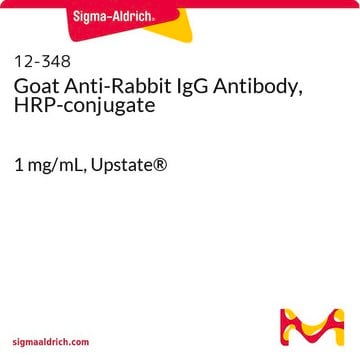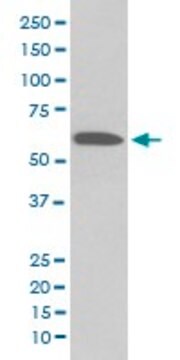05-736
Anti-phospho-Akt1/PKBα (Ser473) Antibody, clone SK703, rabbit monoclonal
clone SK703, Upstate®, from rabbit
Sign Into View Organizational & Contract Pricing
All Photos(2)
About This Item
UNSPSC Code:
12352203
eCl@ss:
32160702
NACRES:
NA.41
Recommended Products
biological source
rabbit
Quality Level
antibody form
purified immunoglobulin
antibody product type
primary antibodies
clone
SK703, monoclonal
species reactivity
human, mouse
manufacturer/tradename
Upstate®
technique(s)
western blot: suitable
isotype
IgG
NCBI accession no.
UniProt accession no.
shipped in
wet ice
target post-translational modification
phosphorylation (pSer473)
Gene Information
human ... AKT1(207)
Specificity
phosphorylated Akt1/PKBa
Immunogen
Peptide containing a pSer that corresponds to amino acid position 473 of human Akt1/PKBa
Application
Detect phospho-Akt1/PKBα (Ser473) using this Anti-Akt1 Antibody, clone SK703 validated for use in WB.
Research Category
Signaling
Signaling
Research Sub Category
PI3K, Akt, & mTOR Signaling
PI3K, Akt, & mTOR Signaling
Quality
routinely evaluated by immunoblot on lysates from mouse NIH-3T3 fibroblasts treated with PDGF
Target description
60kDa
Physical form
Format: Purified
Protein A purified
Protein A purified antibody in 0.1M Tris-glycine, pH 7.4, 0.15M NaCl, 0.05% sodium azide.
Storage and Stability
Stable refrigerated at 2-8°C in undiluted aliquots for up to 1 year from date of receipt.
Legal Information
UPSTATE is a registered trademark of Merck KGaA, Darmstadt, Germany
Disclaimer
Unless otherwise stated in our catalog or other company documentation accompanying the product(s), our products are intended for research use only and are not to be used for any other purpose, which includes but is not limited to, unauthorized commercial uses, in vitro diagnostic uses, ex vivo or in vivo therapeutic uses or any type of consumption or application to humans or animals.
Not finding the right product?
Try our Product Selector Tool.
recommended
Storage Class Code
12 - Non Combustible Liquids
WGK
WGK 1
Flash Point(F)
Not applicable
Flash Point(C)
Not applicable
Certificates of Analysis (COA)
Search for Certificates of Analysis (COA) by entering the products Lot/Batch Number. Lot and Batch Numbers can be found on a product’s label following the words ‘Lot’ or ‘Batch’.
Already Own This Product?
Find documentation for the products that you have recently purchased in the Document Library.
Matthew J Nelson et al.
American journal of physiology. Regulatory, integrative and comparative physiology, 300(4), R993-R1000 (2011-02-11)
The purpose of this study was to test the hypothesis that exercise-induced cardiac adaptations would be attenuated by the free radical scavenger N-2-mercaptopropionyl glycine (MPG). Male Sprague-Dawley rats were divided into four groups (n = 9-13 per group) for 3-4
Cereal and nonfat milk support muscle recovery following exercise.
Lynne Kammer, Zhenping Ding, Bei Wang, Daiske Hara, Yi-Hung Liao, John L Ivy et al.
Journal of the International Society of Sports Nutrition null
Chenran Zhang et al.
BMC cancer, 15, 990-990 (2015-12-23)
Retinoblastoma protein-interacting zinc-finger gene 1 (RIZ1) displays strong tumor suppressive activities, and its expression is often silenced in many types of human tumors. However, the relationship between RIZ1 expression and glioma prognosis remains unclear. The dysregulation of RIZ1 was evaluated
Inducible-NOS but not neuronal-NOS participate in the acute effect of TNF-alpha on hypothalamic insulin-dependent inhibition of food intake.
Juliana C Moraes, Maria E Amaral, Paty K Picardi, Vivian C Calegari, Talita Romanatto et al.
Febs Letters null
Giorgio Zauli et al.
Clinical cancer research : an official journal of the American Association for Cancer Research, 17(4), 762-770 (2010-11-26)
To analyze the effect of the combination of Dasatinib, a multikinase inhibitor, plus Nutlin-3, a nongenotoxic activator of the p53 pathway, in primary B chronic lymphocytic leukemia (B-CLL) patient samples and B leukemic cell line models. The induction of cytotoxicity
Our team of scientists has experience in all areas of research including Life Science, Material Science, Chemical Synthesis, Chromatography, Analytical and many others.
Contact Technical Service








